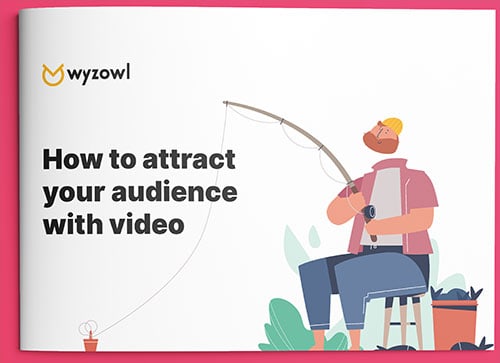Last updated on 17th May 2024
YouTube is the biggest player in the online video space. (It’s not even close!)
But there are other sites, too.
In this article we’ll be taking a look at 10 other video websites, beside YouTube, that are interesting video sharing platforms or video-based social channels for your business to consider.
Let’s start with an established name – Vimeo.
While it was originally focused on user-uploaded videos like YouTube, Vimeo has evolved into more of a business solution.
Their customisable video players, streaming capabilities with interactive features like polls and Q&As, and monetisation tools make it a slick option for creative teams and businesses looking to host portfolio videos and showcase their work in a professional way.
Our Insight
Vimeo is excellent for businesses that prioritise video quality and brand control. It’s particularly well suited for creatives looking to showcase their portfolio work.
Pros:
• High-quality video
• Ad-free
• Customisable player
• Flexible privacy options
Cons:
• Smaller audience compared to YouTube
• Limited discoverability
Expert Tip
Use Vimeo’s customisation options to embed videos seamlessly into your website for a professional look. We reckon the player is a LOT nicer looking and has a more professional feel than embedding videos from YouTube.
With Instagram, you can directly share longer videos right to your main feed to captivate your existing followers.
They’ll play as Reels at first – but viewers have the option to keep watching the full video.
Even better, Instagram’s smart algorithm can help expose your videos to new eyes and grow your audience organically through Instagram’s ‘Explore’ functionality.
Our Insight
Instagram is perfect for brands targeting a younger demographic. It’s great for behind-the-scenes content and quick updates.
Pros:
• Integrated with Instagram
• Mobile-friendly
• Strong engagement – access to potentially huge audience on Instagram
Cons:
• Limited to vertical and square videos
Expert Tip
Leverage Instagram Stories and posts to promote your Instagram videos for increased visibility – and don’t forget to use hashtags as a vehicle to reach new audiences, too.
Facebook knows video, and it’s widely believed that uploading your videos natively instead of sharing links helps boost visibility on this video-hungry channel.
Their Facebook Watch hub curates trending videos matched to your interests, giving you another way to get discovered by fresh audiences.
Pretty cool when you can leverage Facebook’s massive reach, right?
Our Insight
Facebook is powerful for reaching a broad audience and driving engagement through shares and comments. It’s also excellent for community building. But it’s important to be aware that organic reach isn’t what it once was – if you’re aiming to reach big audiences, some ad budget may be required.
Pros:
• Large user base
• Strong sharing capabilities
• Integrated ads
Cons:
• Video content can get lost in the newsfeed
• Less control over video quality
Expert Tip
Post videos during peak engagement times – and particularly, use Facebook Ads to boost your important content. As always with paid ads, start small so you can work out what works and what doesn’t, then scale up.
TikTok’s massively popular short-video format lends itself to entertaining, funny content that lets your brand’s personality shine.
While it’s still evolving for businesses, it provides an engaging way to connect with TikTok’s vibrant, younger-skewed community by tapping into their love of lighthearted, trendy videos.
Our Insight
Perfect for brands that can produce fun, creative content and want to tap into younger audiences. Great for brand personality and trends.
Pros:
• Huge engagement
• Viral potential
• Young audience
Cons:
• Short video format
• Less obvious fit for businesses
Expert Tip
Participate in trending challenges and use popular music to increase the chances of your video going viral. Tiktok is out on its own as a channel, quite distinct from anything else out there – so spend some time looking at successful channels in your niche to get some inspiration and direction.
Think of Dailymotion as YouTube’s cousin – it’s another one that started out very similar to YouTube in purpose and functionality.
But over time it’s evolved more into a video platform geared towards hosting news, entertainment, and topical videos.
While its audience is much smaller than YouTube’s, you can monetise your uploads and it provides another avenue to amplify your reach across the web.
Our Insight
Dailymotion offers a solid alternative for reaching international markets and a diverse audience. It’s good for broad reach but does lack niche focus.
Pros:
• Similar to YouTube
• Large international audience
Cons:
• Less popular in the U.S.
• Ads can be intrusive
Expert Tip
Use tags and descriptions effectively to increase the discoverability of your videos.
Originally a streaming hotspot for video gamers, Twitch has expanded into a livestreaming destination for all kinds of content like podcasts, comedy shows, and more.
It represents an advertising channel to tap into Twitch’s highly engaged community of viewers.
Our Insight
Twitch excels for businesses in the gaming industry or those looking to leverage live interaction. Consistency is key to building a loyal viewer base.
Pros:
• Real-time interaction with viewers
• Large gaming community,
• Subscription options for monetisation
Cons:
• Best suited for live content
• Primarily a gaming platform
• Channel growth requires consistent streaming
Expert Tip
Engage actively with your audience through chat and consistent streaming schedules
Wistia is a video hosting solution built from the ground up for businesses.
Polish up your video presence with sleek, professional player designs, lead generation tools that gate videos, and their integrated Soapbox tool for quick screen and webcam recording. Slick!
Our Insight
Wistia is tailored for businesses needing in-depth analytics and lead generation from their video content. It’s a powerful tool for video marketing and sales integration.
Pros:
• Advanced analytics
• Customisable player
• Lead generation tools
Cons:
• Higher cost
• Limited audience discovery
Expert Tip
In our opinion, Wistia’s player is THE most beautiful and powerful option out there for embedding video content on your website. Throw in lead generation tools like Turnstile to capture viewer information and Wistia is a real winner for brands.
For creative professionals, Behance is Adobe’s network for showcasing portfolios of design, branding, animation, video projects, and more.
It’s more about getting eyes on your work from other creatives for feedback, networking, and potential opportunities rather than hosting viewer-friendly video content.
Our Insight
Behance is fantastic for creative professionals showcasing portfolios. For businesses in creative industries, it provides a platform to gain visibility and feedback.
Pros:
• Great for creative portfolios
• Adobe integration
• Community feedback
Cons:
• Best for creative industries
• Less suitable for general marketing
• Smaller audience base
Expert Tip
Showcase your best work and interact with the community to build your network. It’s not just about ‘being’ there – the community element is crucial here and will help you reach new audiences.
When it comes to premium, enterprise-grade video, Brightcove is the total package.
We’re talking end-to-end solutions like video management, live streaming, interactive experiences, and their ultra high-performance HTML5 video player. No wonder top brands trust them!
Our Insight
Brightcove is an excellent choice for large enterprises needing advanced features and analytics. Its robust platform supports comprehensive video marketing strategies.
Pros:
• Enterprise-level features, extensive analytics
• Monetisation options
Cons:
• Expensive
• Complex for beginners
• Not ideal for small businesses
Expert Tip
Brightcove offers extensive analytics, and this gives you a great starting point to refine your video strategy and improve ROI.
With Loom’s simple video messaging tool, you can quickly record your webcam and screen to share ideas, feedback, updates – you name it – with your team.
No more typing out long-winded emails or scheduling meetings for simple conversations. Just record and share!
Our Insight
Loom is excellent for quick, straightforward video communication. It’s particularly useful for creating tutorials, walkthroughs, and internal communications efficiently.
Pros:
• Easy-to-use
• Great for tutorials and internal communications
• Quick sharing
Cons:
• Limited social sharing capabilities
• Basic editing tools
• Best for shorter videos
• Solely for a particular type of video
Expert Tip
Use Loom for creating quick, informative videos for internal use or client communication
Thanks for reading!
The power of video is vast, and wide-ranging. From video messaging, to hosting, to content amplification and social networking, video is the fuel that drives the engine of growth for many businesses, across niches and industries.
If you take nothing else away from this article, take away this: there’s more to video than YouTube!
Take your pick of the sites we’ve outlined above and you can start to use video in different, exciting ways, generating maximum ROI throughout your business.
But… if after all of that you’re still set on YouTube, don’t worry – we have a host of articles designed to help optimise your presence on the platform. Check out our YouTube header dimensions guide, YouTube SEO tips and How to make a YouTube video for starters.
Hassan is Marketing Manager at Wyzowl. He is an expert in video marketing, video software, promotion & analytics.







